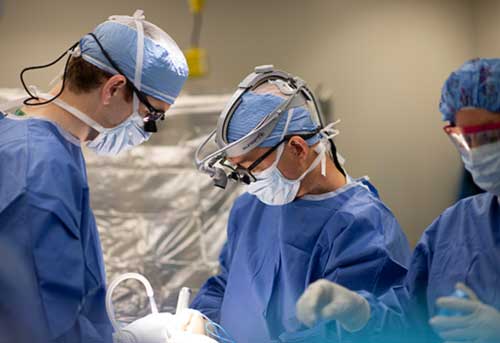Usual Treatments Done by the Best Spine Surgeons in St Louis MO
Usual Treatments Done by the Best Spine Surgeons in St Louis MO
Blog Article
An Introduction of Spinal Column Conditions That Usually Cause Surgical Therapies
Spine conditions such as herniated discs, spine stenosis, and degenerative disc disease regularly require surgical interventions when traditional treatments stop working to ease relentless signs. Understanding the subtleties of each condition and the equivalent medical alternatives, such as discectomy or back blend, is important for effective management.
Herniated Discs
Although lots of individuals with herniated discs might discover relief with conservative therapies, surgical procedure ends up being a needed factor to consider when signs intensify or continue - best spine surgeons in st louis mo. A herniated disc occurs when the soft internal gel of a spinal disc extends through its external layer, possibly leading and pressing nearby nerves to discomfort, feeling numb, or weakness in the extremities
Traditional management generally consists of physical therapy, discomfort medications, and corticosteroid shots, which aim to minimize swelling and enhance feature. However, in situations where these techniques fail to alleviate incapacitating signs and symptoms, medical choices might be explored.
The most common surgery for herniated discs is a discectomy, which includes the removal of the herniated section of the disc to ease pressure on the affected nerve root. In more extreme situations, spine fusion may be required to stabilize the influenced vertebrae.
Individuals are recommended to talk about the potential threats and advantages of surgery with their medical care provider to make a notified choice. Ultimately, the objective of any surgical intervention is to bring back feature, alleviate discomfort, and improve overall lifestyle for individuals dealing with herniated discs.
Spinal Stenosis
Back constriction occurs when the areas within the back slim, leading to increased stress on the spine and nerves. This condition can create in various areas of the spine, including the cervical and back locations, typically because of age-related modifications, such as degenerative disc condition, joint inflammation, or enlarging of ligaments.
Individuals with spinal constriction might offer with symptoms that include discomfort, tingling, tingling, or weak point, mainly in the legs or arms. These symptoms can be aggravated by activities that entail standing or walking, typically leading people to seek alleviation via traditional therapies like physical treatment, medicines, or epidural steroid shots.
Nevertheless, when these non-surgical interventions fall short to supply sufficient alleviation, medical alternatives might be taken into consideration. Common surgical treatments for spinal constriction include laminectomy, which includes the elimination of component of the vertebra to reduce pressure, and spine blend, which supports the damaged area. The choice to go after surgical treatment is usually based on the seriousness of signs, the level of useful problems, and the overall wellness of the person. Prompt diagnosis and management are crucial to stop additional neurological compromise and enhance high quality of life.
Spondylolisthesis
Spondylolisthesis happens when one vertebra slips onward over an additional, bring about misalignment of the spinal column. This condition can arise from various pop over to these guys variables, including hereditary defects, injury, or degenerative adjustments in the spine. It is most typically observed in the back region, particularly at the L4-L5 and L5-S1 levels.

Therapy options vary based upon the severity of the slippage and the signs provided. Traditional procedures, consisting of physical therapy, discomfort administration, and task adjustment, are typically the initial line of protection. Nevertheless, when non-surgical methods fail to ease signs and symptoms or when substantial nerve compression exists, surgical treatment might be required. Surgical alternatives can consist of spinal blend or decompression procedures, targeted at recovering placement and reducing neurological symptoms. Early medical diagnosis and proper monitoring are crucial for ideal results in clients with spondylolisthesis.
Degenerative Disc Illness

People with DDD frequently experience pain that might emit to the legs or arms, relying on the affected area of the spinal column. The condition can be identified via a mix of scientific evaluation, imaging researches, and person history. Therapy options commonly start with traditional steps, consisting of physical treatment, pain administration, and way of living modifications. Nonetheless, when these techniques fall short to give ample relief, medical interventions may be considered.
Surgical options for DDD might consist of spine combination or artificial disc substitute, focused on maintaining the influenced segment and easing pain (best spine surgeons in st louis mo). Eventually, the choice of treatment is embellished, taking into account the extent of the problem, individual health, and way of living variables
Spinal Lumps

Back tumors can occur from various elements, including hereditary proneness, environmental influences, and pre-existing clinical problems. People might offer with a variety of signs, including localized pain, neurological deficiencies, weak point, or modifications in digestive tract and bladder function, depending on the growth's dimension and place.
Surgical intervention may be warranted to ease symptoms, acquire a biopsy, or remove the growth entirely. The objective of surgical treatment is often to unwind neural components and stabilize the spine. Early detection and treatment are Get More Information essential for maximizing outcomes in people with spine lumps.
Conclusion
In recap, back conditions such as herniated discs, spinal stenosis, spondylolisthesis, degenerative disc illness, and back tumors often demand surgical treatment as a result of their potential to trigger significant pain and useful impairment. While conventional therapies might use momentary alleviation, medical options end up being important when signs get worse or linger. Prompt diagnosis and intervention play a crucial function in recovering feature and boosting the top quality of life for afflicted individuals, highlighting the relevance of comprehensive spinal care.

Report this page